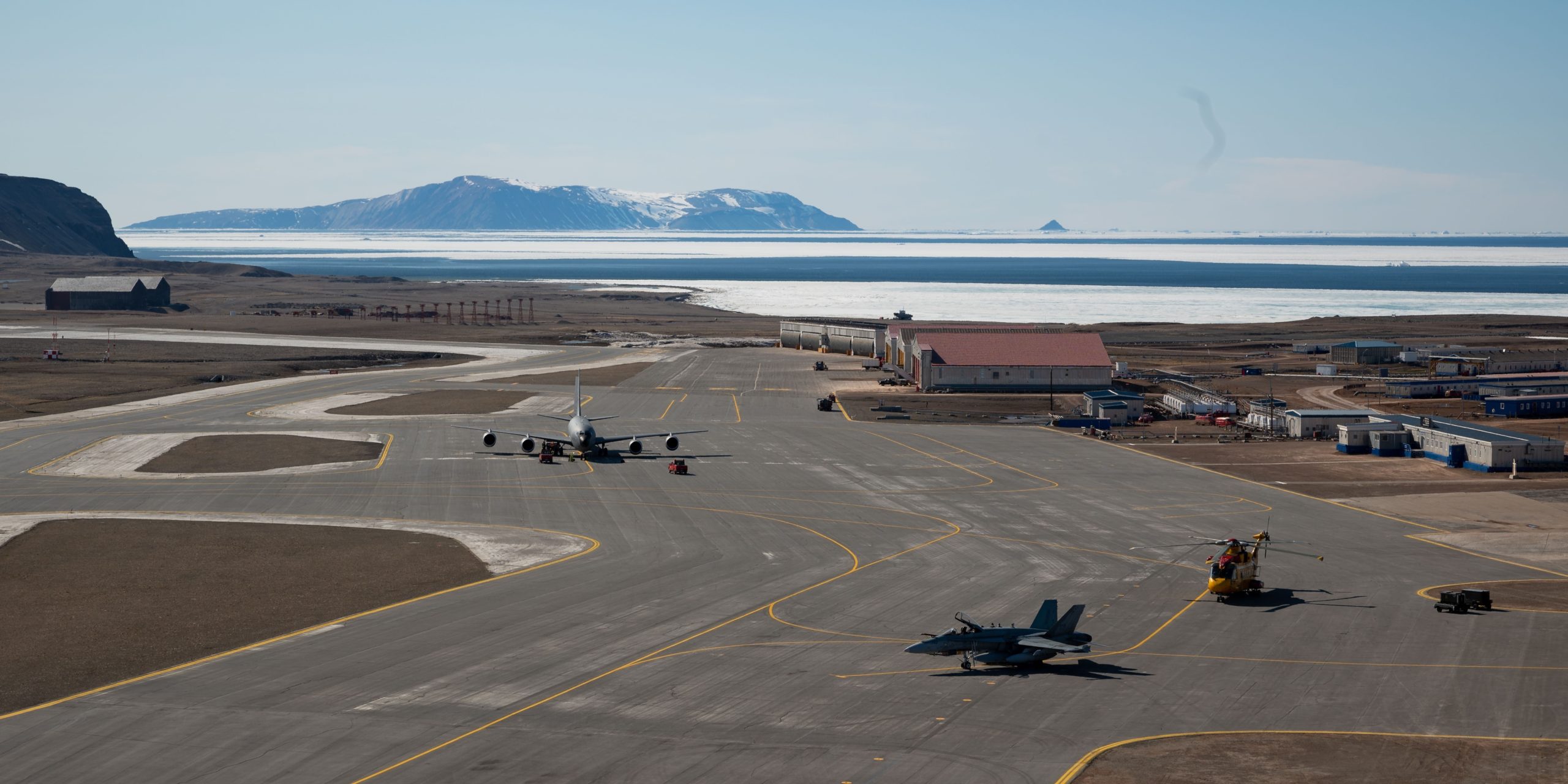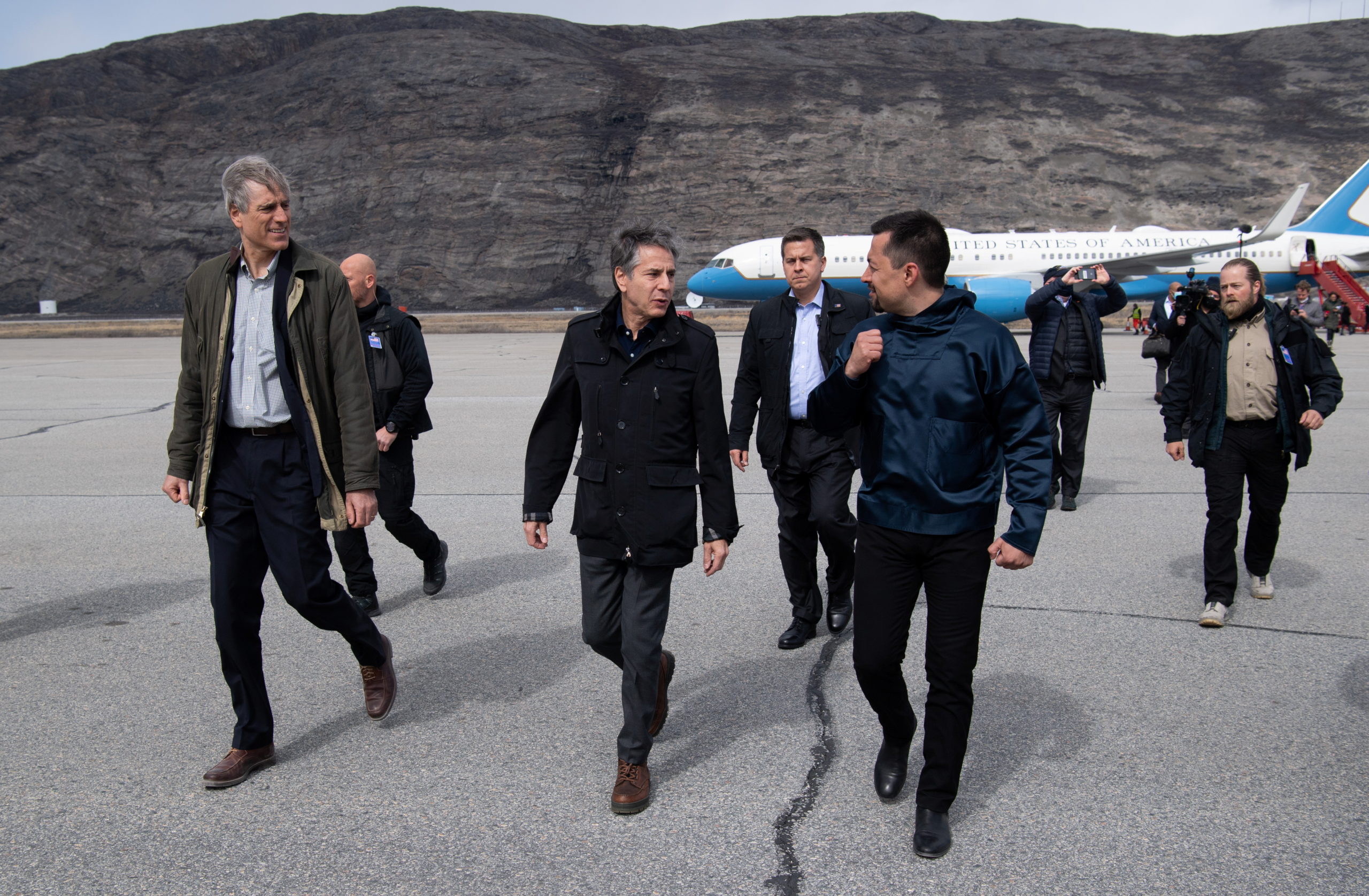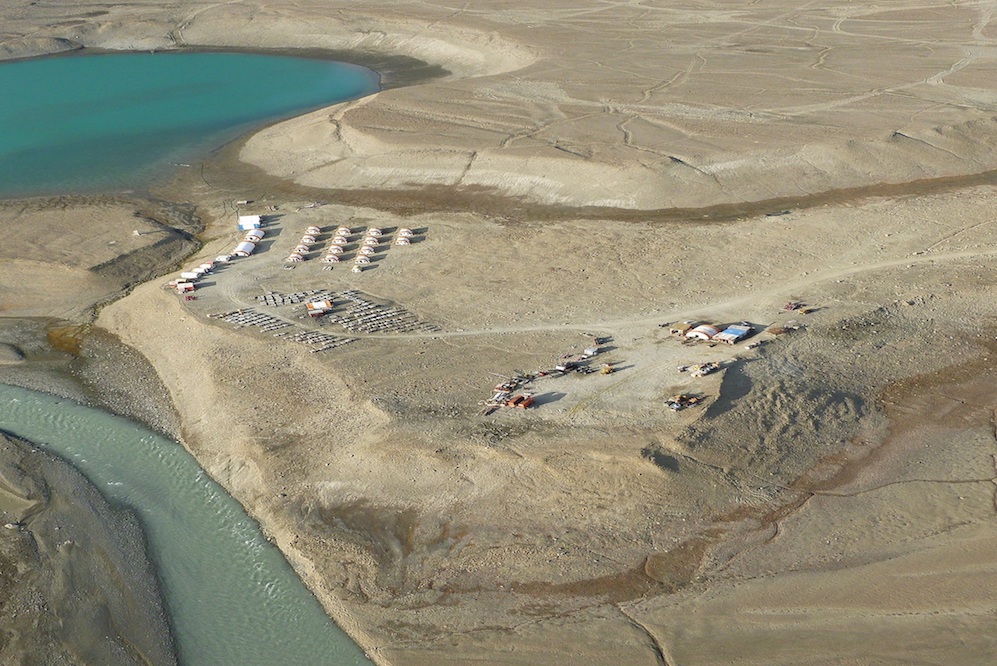A year into Biden’s presidency, U.S. military plans for Greenland remain unclear
A hinted-at expansion of Thule Air Base hasn’t materialized, but U.S. interest in Greenland's minerals is still strong.

Former U.S. President Donald Trump’s suggestion in 2019 that he wanted to buy Greenland signaled an intense strategic U.S. interest in the island, an autonomous country in the Danish realm. But, now, a year into his successor Joe Biden’s tenure, it is still not clear what Washington really wants in Greenland.
The latest news in that regard reached the public only indirectly in late 2021. It was in Danish and woven into an answer from the Danish minister of Foreign Affairs, Jeppe Kofod, to a member of the Danish parliament who had asked what the Danish government knew of any U.S. plans for an upgrade of Thule Air Base in the far north of Greenland.
The reason for this exchange was an article I had written a few days earlier in Weekendavisen, a Danish broadsheet, highlighting how the U.S. Army Corps of Engineers in November 2020 — still in the Trump era — launched a market survey to identify private engineering companies interested in providing architectural and engineering services for a seemingly rather large upgrade to Thule Air Base.
[Great-power politics could undermine Arctic stability, a new Danish threat assessment warns]
It was a non-binding market survey, not a formal tender, but it mentioned a sum that must have had people in the U.S., Canada and elsewhere reaching for their phones. The public announcement of the market survey explained that the plan was to award five-year contracts to five companies to the total tune of $250 million — a quarter of a billion dollars just for architectural and engineering services. The object here was obviously not any small time upkeep of existing facilities at Thule.
There was no indication as to how large the budget for the actual construction at Thule Air Base would be, but there was a neat list of what would most likely be needed — and please allow now a somewhat lengthy quote:
“Construction of new and renovation/upgrade of multiple hangar/buildings, maintenance, training facilities (hands-on/simulators), Aviation facilities, Runways and Taxiways, Aircraft Fueling facilities/distribution, Industrial facilities, Vehicle Maintenance facilities, Research & design facilities (Armament, Munitions and Communications), Munitions and Storage facilities, Dining facilities, Academic Labs, Barracks/dormitories, Academic Facilities, Administrative Office Buildings. Arctic/Cold Region Construction and repair of airfields, runways, taxiways, aprons and Apron refueling systems. Whole building renovations which address interior re-configuration, life/safety, energy conservation, and utility systems.”
The list went on and on:
“Fire suppression and water supply systems, fire alarm and mass notification system, cybersecurity, fire detection/protection/monitoring and controls, heating and ventilation systems, plumbing systems, electrical systems, telecommunication and cabling systems, closed circuit television (CCTV), alarm and card access systems, and public address systems”.
“Topographic surveys, geological surveys, geotechnical investigations, environmental investigations, Master Planning Studies, Value Engineering Studies, Field Investigation Studies, construction support services”.
Even the caretaking of historical buildings at Thule Air Base was mentioned.
When?
A year later, well into Biden’s presidency, when I asked if there was any news as to when all this would happen in Greenland, the U.S. Embassy in Copenhagen had no comment. Only when the Danish minister of Foreign Affairs had to answer in writing a question from Aaja Chemnitz Larsen, one of the two Greenlandic members of the Danish parliament, who was surprised that neither she nor her government in Nuuk had heard anything, did a message from Washington seep through.
“The U.S. authorities have informed (the Danish government) that the market survey has not till now resulted in any concrete tenders, and that it has therefore not led to any construction at the base. Neither is there on the American side any expectation that this will likely happen in the near future,” the answer from the Danish foreign minister read (this translation is mine).
That was all. And I assume that the most likely interpretation by those who live in Greenland and by many others who follow U.S. military activity in the Arctic with mounting interest would read something like this: In 2020, the US Corps of Engineers had very serious thoughts about upgrading Thule Air Base, but now — well into the Biden days — these thoughts are no longer current and there is no immediate political desire to pursue them.
It seemed to be a straight and precise message. But it ran, as I will try to explain, somewhat contrary to a string of other U.S. actions in Greenland and in the rest of the Arctic.
Crucial relations
I should add first, though, that the question of U.S. military activity in Greenland is of course of immense interest first of all to the 57,000 inhabitants in Greenland but also to the rest of the Danish Kingdom of which Greenland is still a part. The ways in which the U.S. decides to pursue its strategic interests in Greenland will impact, for instance, directly on Greenland’s and Denmark’s standing with regard to other countries — Russia in particular, at a time when tension with Russian already at a peak. It will impact Greenland’s economy, its infrastructure, and — especially if more U.S. soldiers are to be stationed in Greenland, even temporarily — the social fabric of Greenland.
In Copenhagen, relations with the U.S. are considered crucial to basically all Danish security and many foreign policy issues. Denmark’s government considers the permanent maintenance of a close military alliance with the U.S. to be at the very core of its responsibilities.
[US, Greenland reach agreement on Thule Air Base contract, long a source of dispute]
As an example, in December, the head of the Danish Defense Intelligence was put under arrest allegedly accused of leaking information to the press. His arrest followed revelations by the media that — among other related issues — the security service had long cooperated much more deeply with those of the U.S. than most Danes had ever anticipated. The connection to Thule Air Base, I admit, is slight, but I mention this illustrate how the advancement of U.S. military ambitions in any part of the Danish Kingdom will play more or less directly into many other strands of politics, including intelligence issues, military budgets, the question of how to calibrate the Danish defense forces in Greenland and the delicate issue of how to handle internal differences between Denmark and Greenland (as well as the Faroe Islands, the third part of the kingdom).
The U.S. wants, for instance, increased “situational awareness” in the Arctic and Denmark has promised to finance and build a large, new radar in the Faroe Islands. The local politicians in Torshavn, the Faroese capital, however, have shown little enthusiasm for this increase in the military infrastructure on their islands. And Pele Broberg, Greenland’s foreign minister until recently, talked openly of his desire to limit Denmark’s military presence in Greenland while strengthening ties to the U.S.

Meanwhile, it is not forgotten how Trump’s idea to buy Greenland seemed to reflect a firm and steadfast U.S. wish to counter Russia’s military build-up in the Arctic and China’s economic and diplomatic inroads in the region. Both are clearly considered to be real and current threats to the U.S., — thus positioning the Faroe Islands and Greenland smack in the center of U.S. strategic concerns.
The recent message from Biden’s Washington that there are no current plans to upgrade Thule Air Base therefore leaves a more basic question still baying for answers: What then does the U.S. military plan in Greenland?
If the Trump administration — including its foreign service and the Pentagon — was so eager to embrace Greenland, reopening the U.S. consulate in Nuuk, investing for the first time ever in Greenland’s civil society and sending frequent signals about about Greenland’s strategic importance, what then are the Biden-administration’s plans for follow-ups?
Mapping Greenland
While we wait, a string of related U.S. actions in Greenland and the rest of the Arctic are keeping observers in both Nuuk and Copenhagen on their toes.
The first recent signal of U.S. intent to invest in additional aviation facilities in Greenland was advertised through the U.S. Embassy in Denmark in 2018.
Since then, high ranking U.S. officials have repeatedly expanded on this theme. According to my sources both in Greenland and Denmark, this has included briefings by U.S. officials in the secret so-called Permanent Committee, where high-ranking U.S., Danish and Greenlandic officials exchange views and information on U.S. military matters in Greenland.

Also, a team of technical experts from the U.S. defense forces have been to Greenland to assess whether two new civilian airports under construction in Nuuk, Greenland’s capital, and in Ilulissat, a town further north, could potentially be useful for the U.S. Air Force. Others have speculated that a deepwater port in Greenland will soon be among U.S. naval priorities.
According to other sources in Denmark and Greenland, including military sources, U.S. satellites under the auspices of the National Geospatial-Intelligence Agency in Springfield, Virginia, one of the arms of the U.S. intelligence community, have lately been steadily collecting data about every inch of Greenland not covered by ice; this is territory the size of Norway or two-thirds the size of Afghanistan. In an effort that also involves the Danish and Greenlandic authorities, this immense amount of data will be turned into electronic, seamless maps (think Google Maps, just better). These maps will enable smoother and safer operations by U.S. and other military forces in Greenland and, as an extra bonus, also indirectly benefit the making of maps for Greenland’s civilian life.
The runways at Thule Air Base have recently been equipped with extra so-called tail-hooks; wires fastened to concrete structures which can help fighter planes brake more rapidly when landing. Long-planned demolition of older structures at the base have been canceled and among Danish military brass, rumors of upcoming larger-scale upgrades have been circulating for some time.
In 2020 and in 2021 — bridging the Trump and the Biden presidencies — the U.S. and the Canadian air forces conducted two major exercises in the Arctic dubbed Amalgam Dart. According to Skies Magazine, the exercise in June 2021 involved more than a thousand troops, 60 fighter jets and other aircraft and Thule Air Base played a key role.
“I have been doing NORAD since 1998 when I first started flying F-18s, and I can’t recall a live fly exercise this large ever in my career,” Maj. Gen. Eric Kenny, commander of 1 Canadian Air Division and Canadian NORAD Region told the magazine. According to a news release from the North American Aerospace Defense Command, Thule Air Base was the center of the first-ever “wet wing refueling” test by CONR, the Continental U.S. NORAD Region, a part of the U.S. defense forces that provides defense for the continental United States. Refueling trucks were airlifted to Thule, fuel was brought in on aircraft normally used for refueling other aircraft in the air. Fuel was pumped into the refueling trucks and finally used to refuel F-16 fighter planes on the ground in Thule.
“The exercise went very well and provided an excellent opportunity for our Airmen to work in a deployed location to refine Agile Combat Employment processes for maturing the C-17 capability for future wet-wing refueling missions,” said Chuck Keasey, CONR-First Air Force Aircraft Maintenance Branch Chief. “Our proven ability to conduct wet-wing refueling enhances our capability to defend North America,” he said.
In another illustration of increased U.S. focus on the Arctic, the U.S. last year in a deal with the Norwegian government was awarded “unhindered access” to four military installations in Norway, two of which are in the Norwegian Arctic. From there, U.S. fighter planes, military vessels and submarines now conduct maneuvers in the North Atlantic ever closer to Russia’s main Arctic bases. And in a few weeks, the mighty USS Harry Truman, an aircraft carrier, will team up with HMS Prince of Wales, a British equivalent, for one of the largest military exercises ever in the Arctic parts in Norway; military cooperation with Sweden and Finland are also on the rise.
[The US Air Force’s first Arctic strategy emphasizes geopolitics, space]
Several of the most recent Arctic strategies from various branches of the U.S. military talk about new and growing threats to the U.S. from the north, and Thule Air Base — even if some structures there date all the way back to the 1950s — is listed as a key U.S. asset in this regard.
As associate professor Rob Huebert, an Arctic security expert from the Department of Political Science at the University of Calgary, told me in December:
“An upgrade to Thule Air Base would basically mean that the U.S. was investing precisely as they have written in their strategies that they would over the last couple of years. It would fit nicely into the pattern that has already been drawn by the U.S. in northern Norway and at the U.S.’s own military facilities in Alaska,“ Huebert said.
“It is a simple analysis. You have a shorter reaction time today than previously,” in case of a Russian attack, he said. ”And the Americans think they need to do something about it.”
Strategic minerals
To sum up, there are no signs that U.S. interests in Greenland are diminishing. Quite the contrary. When Trump announced his wish to buy Greenland, he talked of the strategic minerals in Greenland’s subsoil, and this particular priority seems to also still have Washngton’s keen interest; the U.S. is also keen to thwart any risk that China might gain control over Greenland’s resources.
As an example, on December 7 the Australian mining company Ironbark happily announced that the U.S. investment bank EXIM, the Export-Import Bank of the United States’ government, had formally confirmed its interest in investing some $657 million in a huge zinc mine at Citronen Fjord in a remote part of extreme northeastern Greenland which Ironbark has worked on for years.
Zinc is on the U.S. list of strategic minerals; in increasingly short demand while still crucial for, among other things, galvanizing iron. According to Ironbark’s announcement, EXIM’s investment would basically finance the entire mine in Citronen Fjord. Also, it would effectively kill Ironbark’s previous intention to let the Chinese state-controlled mining giant China Nonferrous Metal Mining Group finance the project.
According to the Financial Review EXIM’s financing is a result of a U.S. government lender’s special “402A program” designed to help companies compete with China. Australia’s former foreign minister Alexander Downer, one of Ironbark Zinc’s directors, told Financial Review that: “the 402 program was set up, in a sense, as a way of competing with China’s Belt and Road Initiative.”

“It has strategic intention, and it has been legislated by Congress and then implemented by regulation by the EXIM Bank. And we’re the first standalone project to get approval as a 402A project,” Downer said.
Next in line may be Greenland’s large deposits of minerals from the so-called rare earths, which are of particular significance to the U.S. arms industry.
In July 2019, only a few weeks prior to his admission that he would like to buy Greenland because it would be “strategically nice,” Trump issued a presidential memorandum to his Defense Secretary explaining that domestic production of rare earth minerals was no longer sufficient to secure U.S. supplies, and that foreign sources would have to be pursued.
That same summer, Greg Barnes, an Australian miner with a license to mine rare earths in south Greenland, was summoned, as he told me in 2021, to the White House with short notice and questioned for several hours by a panel of more than 10 people from the president’s staff and the U.S. intelligence community on how he intended to proceed.
Later the same year, an airborne survey of mineral resources in south Greenland was carried out with U.S. funding. And according to sources in Nuuk, a delegation of high-ranking officials from the U.S. State Department that visited Greenland in late 2019 and included Secretary of State Mike Pompeo’s chief adviser, Thomas Breckbull, was especially preoccupied with Greenland’s rare earths.
Biden’s administration has not yet exercised the same zeal on the ground in Greenland, but it is obviously aware of the pressure to secure ample supplies of rare earth minerals for the U.S. And Greenland just happens to be home to sizable, proven deposits.
In February 2021, the U.S. Department of Defense announced an investment of some $30 million in a rare earth refinery in Texas. In June 2021 the Biden administration established a “Supply Chain Disruptions Task Force” to combat a range of potential shortfalls, including that of rare earths: “China accounts for an outsized share of the world’s refining capacity, meaning that even if the United States were to diversify our sources of critical minerals or increase domestic extraction, we would still be reliant on China for processing before use in end-product manufacturing,” a fact sheet from the White House said, heralding much action and investment. A White House background report was equally adamant: “The United States must secure reliable and sustainable supplies of critical minerals and metals to ensure resilience across U.S. manufacturing and defense needs” it said. In December 2021, Biden issued his own presidential memorandum focused, like Trump’s, singularly on rare earths:
“Shortfalls”, Biden wrote, “would severely impair national defense capability.”
Again, Greenland’s rare earth deposits are most likely still blinking visibly on the radar of the planners and strategists in Washington. However, like in the military sphere, it might be that at this point in time nobody in the new administration has yet figured out exactly how to proceed.
Danish journalist/author Martin Breum is a frequent contributor to ArcticToday. His latest book Grønland og den amerikanske forbindelse (Greenland and the American connection, available in Danish only) was published last fall.
The views expressed here are the writer’s and are not necessarily endorsed by ArcticToday, which welcomes a broad range of viewpoints. To submit a piece for consideration, email commentary (at) arctictoday.com.





